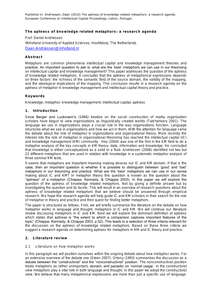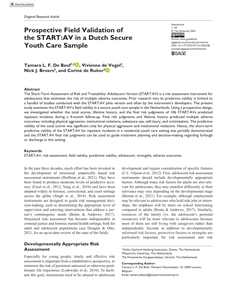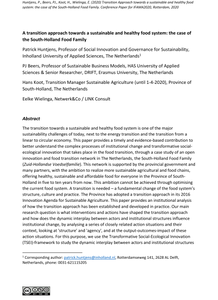Every year I talk to many entrepreneurs about business transfers and acquisitions. Only rarely do they tell me that it was a cinch. Buying or selling a business is complex. For a start, a business should be shipshape from an organizational and administrative perspective, while several legal and fiscal matters also affect the transaction. Moreover, many parties are involved in a business transfer: the buyer and the seller, of course, but also the employees, the spouse and/or family of the entrepreneur, the customers and suppliers. Emotions and trust also play a central role in selling a firm. Many owner/managers find it hard to abandon their business. The fact that a transaction of fixed assets may also be involved is another complicating factor. Is it a good thing to include fixed assets in the sale, or in fact the reverse? Considering that most people find it quite hard to sell their own house, engaging an estate agent to do it for them, it is understandable that buying and selling a business is a transaction fraught with difficulties.
DOCUMENT

Metaphors are common phenomena intellectual capital and knowledge management theories and practice. An important question to ask is: what are the ‗best‘ metaphors we can use in our theorizing on intellectual capital and knowledge management? This paper addresses the question of the aptness of knowledge related metaphors. It concludes that the aptness of metaphorical expressions depends on three factors: the richness of the semantic field of the source domain, the validity of the mapping, and the ideological implications of the mapping. This conclusion results in a research agenda on the aptness of metaphor in knowledge management and intellectual capital theory and practice.
DOCUMENT

Stevenson & Landström (2002) state that Opportunity, Ability and Motives predict entrepreneurship in general. Connecting thirty previous studies we test if the market awareness, endurance, planning and preparation as entrepreneurial ability factors, staff as opportunity factor and the reason for transfer as motive predicts three short term performance (needed transfer time, satisfaction and emotional attachment after transfer). We tested our hypotheses on a representative sample of 130 Dutch business owners who succeeded in a business transferring in 2005 and 2006. Market awareness predicts a faster transfer. Surprisingly more planning and preparation is the best predictor for a long transfer time as does the absence of the selling business owner. More or less forced transfers (illness, declining performance) predict lower satisfaction were as endurance predicts a higher satisfaction. This is valuable information for buyers, business brokers, accountants and bankers. The operationalisation of transfer performance seems vital. All main predictors, even the control variables, show only effect on either the needed transfer time (effectiveness measure) or satisfaction (experience measure). This confirms earlier findings (Van Teeffelen, 2007b). Our common challenge in future is to compare internationally the succeeded, non-succeeded transfer and exits.
DOCUMENT
Titel: The Exodus from the Netherlands or Brain Circulation: Push and Pull Factors of Remigration among Highly Educated Turkish Dutch Auteurs: Gürkan Çelik and Ton Notten In: European Review, 22 (3), 2014, pp. 403-413 The exodus from the Netherlands or brain circulation: Push and pull factors of remigration among highly educated Turkish-Dutch An increasing number of Turks, the Netherlands’ largest ethnic minority, are beginning to return to their country of origin, taking with them the education and skills they have acquired abroad, as the Netherlands faces challenges from economic difficulties, social tension and increasingly powerful right wing parties. At the same time Turkey’s political, social and economic conditions have been improving, making returning home even more appealing for Turkish migrants at large. This article gives explanations about the push and pull factors of return migration. The factors influencing return to one’s country of origin are “pulls”. It is assumed that remigration is more affected by positive developments in the country of origin than by negative developments in the country of residence. Civil society, business world and the Dutch government can develop policies to bind these capable people to the Netherlands, at least in the form of “brain circulation” so that they can serve as “bridge builders” between the two countries. Keywords Return migration, integration, Turkish-Dutch, Turkish migrants, brain circulation =============================================================================== SAMENVATTING De uittocht uit Nederland of breincirculatie: Push- en pull-factoren van remigratie onder hoogopgeleide Turkse Nederlanders. In Nederland zien we een lichte toename van het aantal Turken, de grootste etnische minderheidsgroep in Nederland, die terugkeren naar hun land van herkomst. Ze exporteren daarmee goede opleidingen en vaardigheden die ze in Nederland verwierven. De oorzaken: de economische neergang, sociale spanningen en de groeiende invloed van extreemrechtse partijen. Tegelijkertijd verbeteren in Turkije de politieke, sociale en economische omstandigheden die steeds meer aantrekkingskracht uitoefenen op immigranten in dat land. Dit artikel gaat in op de push- and pull-factoren voor remigranten. Pull-factoren beinvloeden iemands terugkeer naar zijn land van herkomst. Aangenomen wordt dat zo’n remigratie sterker wordt bevorderd door positieve ontwikkelingen in het land van herkomst dan door negatieve (push-factoren) in het land waar men op dat moment woont. De civil society, het bedrijfsleven en de Nederlandse overhead kunnen een beleid ontwikkelen dat verdienstelijke inwoners weet te behouden, hen op z’n minst kan inschakelen als bruggenbouwers en aldus kenniscirculatie mogelijk maakt tussen beide landen. Trefwoorden Retourmigratie, integratie, Turkse Nederlanders, Turkse migranten, kenniscirculatie, breincirculatie
DOCUMENT

Dutch National Sports Organizations (NSFs) is currently experiencing financial pressures. Two indications for this are described in this paper i.e. increased competition in the sports sector and changes in subsidy division. Decreasing incomes from subsidies can be compensated with either increasing incomes from a commercial domain or increasing incomes from member contributions. This latter solution is gaining interest as a solution for the uncertainties. Many NSFs have therefore participated in a special marketing program in order to enlarge their marketing awareness and create a marketing strategy, in order to (re)win market share on the sports participation market and gain a more stable financial situation. This paper introduces my research related to the introduction of marketing techniques within NSFs and the change-over to become market oriented. An overview of existing literature about creating marketing strategies, their implementation, and market orientation is given. This outline makes obvious that the existing literature is not sufficient for studying the implementation of marketing techniques and market orientation within NSFs. Therefore, it shows the scientific relevance of my research. The paper concludes with the chosen research methodology.
DOCUMENT
The Short-Term Assessment of Risk and Treatability: Adolescent Version (START:AV) is a risk assessment instrument for adolescents that estimates the risk of multiple adverse outcomes. Prior research into its predictive validity is limited to a handful of studies conducted with the START:AV pilot version and often by the instrument’s developers. The present study examines the START:AV’s field validity in a secure youth care sample in the Netherlands. Using a prospective design, we investigated whether the total scores, lifetime history, and the final risk judgments of 106 START:AVs predicted inpatient incidents during a 4-month follow-up. Final risk judgments and lifetime history predicted multiple adverse outcomes, including physical aggression, institutional violations, substance use, self-injury, and victimization. The predictive validity of the total scores was significant only for physical aggression and institutional violations. Hence, the short-term predictive validity of the START:AV for inpatient incidents in a residential youth care setting was partially demonstrated and the START:AV final risk judgments can be used to guide treatment planning and decision-making regarding furlough or discharge in this setting.
DOCUMENT

The transition towards a sustainable and healthy food system is one of the major sustainability challenges of today, next to the energy transition and the transition from a linear to circular economy. This paper provides a timely and evidence-based contribution to better understand the complex processes of institutional change and transformative social-ecological innovation that takes place in the food transition, through a case study of an open innovation and food transition network in The Netherlands, the South-Holland Food Family (Zuid-Hollandse Voedselfamilie). This network is supported by the provincial government and many partners, with the ambition to realize more sustainable agricultural and food chains, offering healthy, sustainable and affordable food for everyone in the Province of South-Holland in five to ten years from now. This ambition cannot be achieved through optimising the current food system. A transition is needed – a fundamental change of the food system’s structure, culture and practice. The Province has adopted a transition approach in its 2016 Innovation Agenda for Sustainable Agriculture. This paper provides an institutional analysis of how the transition approach has been established and developed in practice. Our main research question is what interventions and actions have shaped the transition approach and how does the dynamic interplay between actors and institutional structures influence institutional change, by analysing a series of closely related action situations and their context, looking at 'structure' and 'agency', and at the output-outcomes-impact of these action situations. For this purpose, we use the Transformative Social-Ecological Innovation (TSEI)-framework to study the dynamic interplay between actors and institutional structures influencing institutional change. The example of TSEI-framework application in this paper shows when and how local agents change the institutional context itself, which provides relevant insights on institutional work and the mutually constitutive nature of structure and agency. Above institutional analysis also shows the pivotal role of a number of actors, such as network facilitators and provincial minister, and their capability and skills to combine formal and informal institutional environments and logics and mobilize resources, thereby legitimizing and supporting the change effort. The results are indicative of the importance of institutional structures as both facilitating (i.e., the province’s policies) and limiting (e.g. land ownership) transition dynamics.
DOCUMENT

Toeleverende bedrijven in de Brainport regio zijn veelal te typeren als high mix low volume (HMLV) productieomgevingen. Deze bedrijven kenmerken zich door een breed aanbod aan mogelijke producten (grote variëteit in producten), die veelal in lage volumes geproduceerd worden. Vaak zijn dit klantspecifieke producten die eenmalig, of incidenteel geproduceerd worden. Deze bedrijven focussen zich traditioneel op efficiënt gebruik van resources, waarbij bezettingsgraad en kostendekking relevant zijn. De toenemende klantvraag in de regio leidt tot druk op de productiecapaciteit. Een eerste intuïtieve reactie van deze bedrijven is om de bezettingsgraad van machines verder te verhogen. Om de kosten (Cost) beheersbaar te houden, wordt niet direct geïnvesteerd in extra capaciteit. Een ongewenst neveneffect is dat tijdigheid (Delivery, zoals levertijden, leverbetrouwbaarheid, flexibiliteit) en kwaliteit (Quality) verder onder druk komen te staan. De ogenschijnlijke tegenstrijdigheid tussen kosten en tijdigheid in deze HMLV-productieomgevingen, is een vaak terugkomend vraagstuk bij praktijkgerichte onderzoeken die door Fontys Technische Bedrijfskunde studenten uitgevoerd worden. Dit resulteert in de volgende onderzoeksvraag: Welke subaspecten zijn mogelijk relevant voor de prestatie met betrekking tot Quality, Delivery en Cost (QDC) van een HMLV-productieomgeving?
DOCUMENT

Technologische vooruitgang dient twee tegengestelde verlangens. Het verlangen van de ultieme controle over de werkelijkheid en het verlangen naar afstand tot diezelfde werkelijkheid. Het verlangen naar grip en verlichting. Het verlangen naar macht en virtualisering. Dat zijn oude verlangens, die al eeuwen leven in de mythes rond 'de golem' en de mythe van 'de engelen'. De geschiedenis van de technologische vernieuwing laat zich lezen als een verhaal van steeds meer ingrijpen in de werkelijkheid, en tegelijkertijd als een terugtrekkende beweging uit die werkelijkheid. Elke technologische vooruitgang versterkt dat spanningsveld. En omdat digitale technologie met een logaritmisch versnelling vooruit dendert, wordt die kloof in het verlangen pijlsnel groter. Bioproducten online bestellen met je iPad. De beelden van je trektocht door ongerept natuurgebied online bewaren in ‘the cloud’. Een actiegroep voor het behoud van een exotische, uitstervende diersoort op facebook… De samenleving heeft behoefte aan nieuwe mythes waarrond ze de wijzigende structuren kan organiseren. Het zijn mythes die ons laten samenwerken - of het nu om een religie gaat, de mythe van de waarde van geld, de mythe van gerechtigheid, van democratie… Kunstenaars leven in de dynamiek van de samenleving. Hun werk is ook onderhevig aan de dwang van technologische vooruitgang. Maar door een stap achteruit te zetten, afstand te nemen en kritisch te kijken naar een logaritmisch snel veranderende samenleving, kunnen ze nieuwe verhalen scheppen, nieuwe wegen tonen, nieuwe beelden, nieuwe mythes... Net zoals de beelden van engelen en de verhalen van de golem uit de middeleeuwen (en daarna) krachtige, tijdloze mythes toonden. Omdat de computer onvermijdelijk beter wordt in alles wat objectief meetbaar is (dat is bijna een tautologie), wordt de skill van het creatieve denken, van het ongedachte bedenken... 'the unique selling point' van de mens. Kunst heeft niet alleen toekomst. Het is de toekomst.
DOCUMENT
